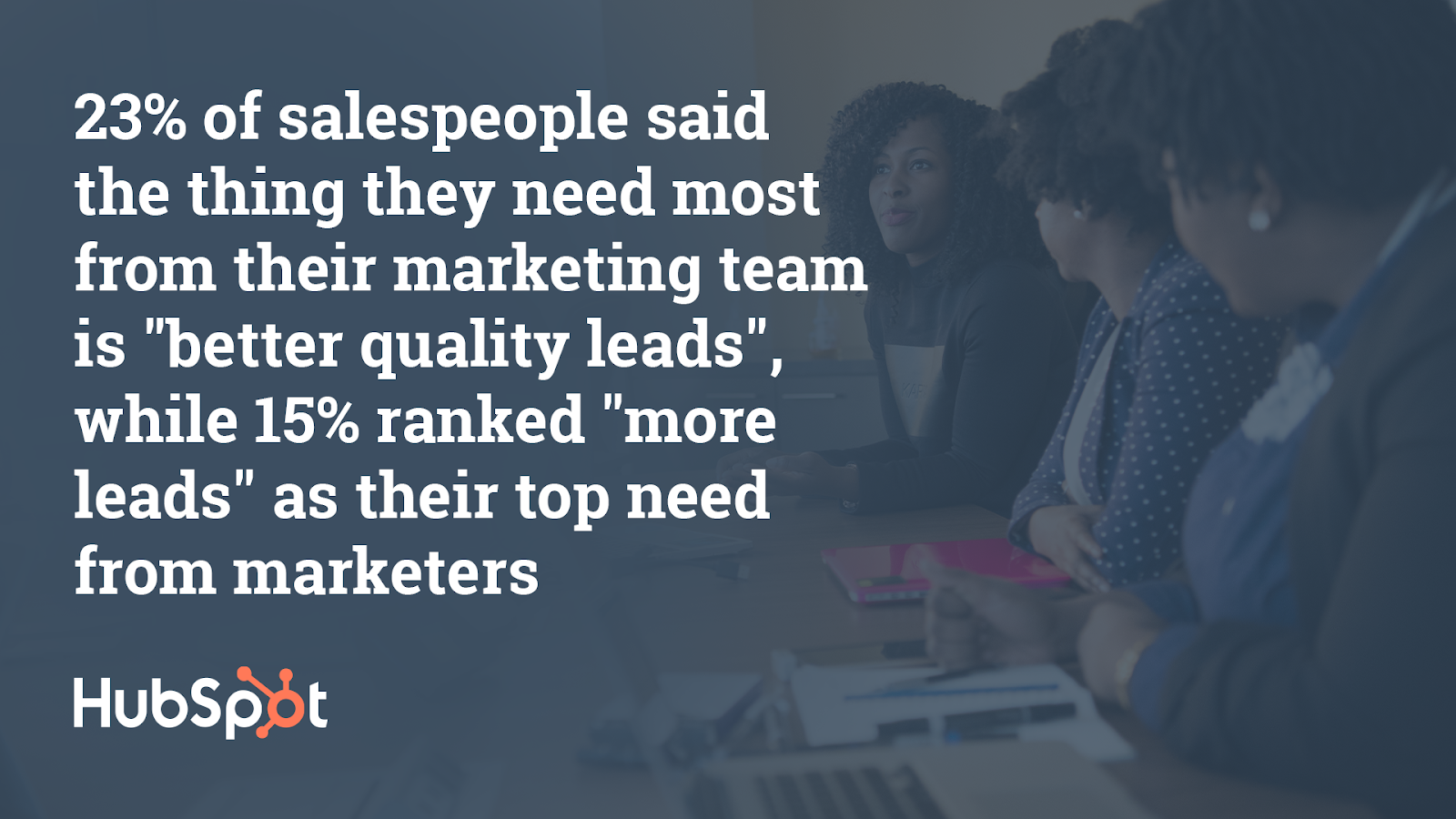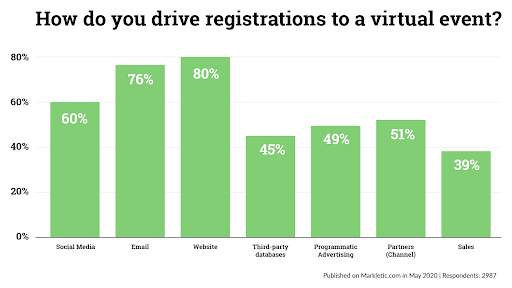The digital revolution has changed so much of what we thought we knew about B2B (business-to-business) lead generation. Long gone are the days of buyers relying solely on information from sales representatives to make their decisions. Nowadays, B2B buyers are already 57% of the way through the buying process before they even speak to a sales rep.
These rapid changes mean the B2B marketing team has become more integral to the lead generation process and the sales journey than ever before. Digital marketing was supposed to make life easier, but 61% of B2B marketering tools still have difficulty generating high-quality leads. So what’s the problem?
Source: Hubspot
Some argue that a lack of training in new lead generation tactics has led to misplaced time and effort on old-school techniques that no longer bear fruit, others blame a lack of funding or resources. There’s no single reason why marketers today are struggling with lead generation; the problem is multifaceted, and as such, so is the solution. But before we get into that, let’s cover some basics…
What is B2B Lead Generation Strategy?
B2B lead generation strategy is the process of generating interest in your company’s products or services from potential customers, or ‘leads’, to boost future sales and revenue. Leads are gained using tactics and techniques including, but not limited to, cold calling, emailing, social media promotion and outreach, etc.
Before you start, it’s essential to acknowledge that generating the right leads is more important than merely producing thousands of uninterested, irrelevant ones that don’t go anywhere. So, make sure you know who your target audience are and have clearly defined segments that you’re going to speak to with your B2B lead generation strategy. Undertaking this vital planning stage will help you to understand where your target audience resides and how best to communicate with them, and in turn, generate higher quality leads for your sales team.
B2B Lead Generation Strategy that Works in 2022
When talking about B2B lead generation strategy, there are two categories often used to describe where a lead resides within their buyer’s journey: MQLs (Marketing Qualified Leads) and SQLs (Sales Qualified Leads).
B2B lead generation strategy primarily exists to accumulate MQLs; middle of the funnel audience members who have displayed an interest in your product or services by interacting with your brand in some manner. MQLs are then nurtured down the funnel using further marketing techniques and become SQLs when they display intent to buy. At this point, you can hand over the lead to your sales team.
Source: Wild Audience
And, voila! The B2B lead generation strategy in a nutshell.
Only joking, it’s a lot more complicated than that… So, let’s take a more in-depth look at the B2B lead generation strategies that are working for marketers in 2022.
Organic SEO
If, like 45% of small businesses owners, you don’t know what I mean when I say SEO, let me explain. SEO stands for search engine optimisation and refers to the process of increasing the quality and quantity of traffic to your website. The organic part of ‘Organic SEO’ simply means unpaid – traffic that you acquire without the help of digital advertising.
There are three key areas you need to think about when attempting to optimise your website’s SEO for organic traffic:
- On-page SEO
The technical stuff like keywords, meta-titles, body tags (H1, H2, etc.), alt tags for images, site-maps.xml.
- Off-page SEO
Activities that are undertaken outside of your brand’s website that increases its authority, for example, backlinks, guest blogs, social media, etc.
- Quality Content
Search engines prioritise content that is valuable to readers, meaning informative and insightful content is a must, along with user experiences (UX) factors like page loading speeds and responsive design for mobile and tablet use.
One problem that B2B marketers face is the regularly changing goal-posts of optimising SEO for lead generation. It always seems like there’s a new theory being lauded as the number one way to ensure your content ranks on page 1 of Google.
CRM specialists, Hubspot’s, most recent revelation to shake up the world of organic SEO was topic clusters and pillar pages. An inbound marketing technique that sees publishers focus on a keyword topic, and create a large resource (pillar page) on that topic and then link out to related content, such as blogs, videos, guides, etc. The increased focus and keyword density can see organic traffic rise exponentially.
Check out this example of Hurree’s Marketing Strategy pillar page in action to help you get started on your own.
Content Marketing
Quality content may be a factor when considering your SEO optimisation, but it’s also proven to be the major driving force behind many B2B marketer’s lead generation success.
Content marketing is the act of producing and distributing content to broaden your audience, build relationships with consumers and generate leads by providing value. As we mentioned at the beginning of this blog, the B2B buyer’s journey has changed; 68% of B2B buyers now prefer to conduct their own online research into a product before speaking with a sales rep. This is where quality content that informs rather than sells is imperative.
Through your content marketing strategy, you should create discoverable content that is SEO-optimised and has a responsive UX for mobile-viewing- since 61% of B2B leads now conduct research on a mobile device. A diverse content marketing strategy that incorporates blogs, videos, gated guides or e-books, and even courses, will help you foster your position as a thought-leader in your industry, create a great user experience for your audience by providing them with straightforward, valuable insights, and build trust with prospects that convert into leads.
Source: HelloBar
Virtual Events
In any other year than 2020, this list would most definitely include hosting and attending events as a top B2B lead generation strategy. According to a CMI study, 81% of B2B marketers use them because they have been the most successful lead generation tactic in B2B for the last 6 years. However, we all know that this year is different, and we, as marketers, need to adapt quickly. So, we move to virtual events.
To deal with the pandemic, many long-standing trade shows and conferences have diversified by moving their events online. By utilising tools such as Zoom to host webinars, transforming your conference talk content into a podcast, or signing up to be a speaker at a digital e-conference, you can assure that your event-based lead generation quotas are met or even exceeded.
Just like using traditional B2B events for lead generation, you will need to put in the effort to promote your virtual events. Creating social media content that links to a highly optimised, a high-converting landing page is a great way to spread the word and get prospects signed up for your event.
Source: Markletic
Lifecycle Segmentation
Once you have collected some prospect information such as an email address, you can deploy email marketing tactics to nurture these prospects into leads. It’s likely that you have a number of prospects who have already interacted with your brand on some level, you may also have some who are very close to converting into sales qualified leads, and you might even have some cold email lists that you need to introduce yourself to.
At this point, you would be foolish to try to speak to all of these prospects with the same messaging; it’s imperative that you show your prospects you care about them as people, not just numbers and KPIs. Your prospects go through a journey when they set out to find a product to solve their problems.
Lifecycle segmentation is a form of market segmentation; the process breaks down large amounts of data into smaller groups based on shared characteristics, for example, where they are in the buyer journey. You can break you email prospects down into 3 main categories:
- Awareness (no prior knowledge of your brand)
- Consideration (some brand interaction, i.e. has viewed 3 blogs on your website)
- Decision (high-level of brand interaction, i.e. has viewed more than 3 blogs on your website as well as your pricing page).
Brands that utilise behavioural insights outperform their peers by 85% in sales growth and more than 25% in gross margin. With B2B lead generation, you should always deploy different messaging for different stages of this journey, to ensure that your prospects are receiving content that is personalised to their specific needs.
Summing Up
Our rapidly changing world waits for no marketer, and B2B lead generation strategy is changing fast. Above you will find just a few of the ways that you can boost your lead generation activity, there’s no quick fix, however, each tactic will take time, testing, and optimisation to conquer and see results. So, make sure you set goals, track your progress, and analyse your results.







Pingback: 5 Must Have Tools To Super-Charge Your Sales Engine
Pingback: The Biggest Myth About Business Leads Exposed -
Pingback: 12 Strategics for Malaysia B2B Lead Generation Website | Hooi Jacky's Blog
bing bring me here. Thanks!
Very nice excellent work done by you with that article.Thanks for this really interesting article! for more info visit our site:- http://vyakar.com/
It is very detailed piece of content. thanks for sharing it. You may read similar artcles here [link removed]